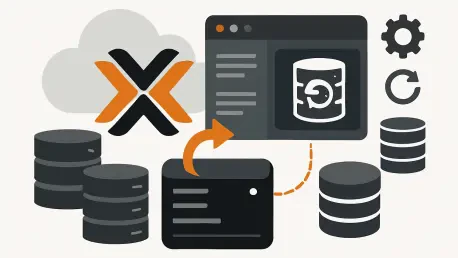In today’s rapidly advancing digital landscape, virtualization platforms like Proxmox Virtual Environment (VE) have become indispensable for businesses seeking efficient management of virtual machines and containers. Renowned for its open-source nature, flexibility, and cost-effectiveness, Proxmox VE empowers organizations to streamline IT operations across various scales. However, with the increasing reliance on virtualized environments comes the pressing need to protect critical data from threats like hardware failures, cyberattacks, and human errors. While built-in backup tools within Proxmox offer a starting point, they often lack the scalability and robustness required for comprehensive, enterprise-grade data protection. This gap highlights the importance of specialized backup software tailored to meet the demands of modern IT infrastructures. This in-depth exploration dives into the leading Proxmox backup solutions available in the current year, offering a detailed comparison of their features, strengths, and suitability for different organizational needs. From small businesses to sprawling enterprises, the risk of data loss looms large, and selecting the right backup tool can be the difference between swift recovery and devastating downtime. The following sections aim to guide decision-makers through the evolving landscape of data protection, shedding light on what distinguishes the top contenders in this critical field.
The Critical Role of Backup Software for Proxmox VE
The necessity of a robust backup strategy for Proxmox VE cannot be overstated, especially given the potential consequences of data loss in virtualized environments. Whether stemming from unexpected hardware malfunctions, insidious ransomware attacks, or simple user mistakes, the impact of losing critical information can paralyze business operations and lead to significant financial losses. Proxmox’s native backup capabilities, while useful for basic scenarios, often fall short in delivering the performance, scalability, and reliability that larger or more complex setups demand. Specialized backup software addresses these shortcomings by providing advanced functionalities designed to safeguard data across diverse and dynamic IT ecosystems. Beyond merely creating copies of data, these tools ensure that recovery processes are swift and efficient, minimizing downtime and maintaining business continuity even in the face of disaster. For organizations relying on Proxmox VE, investing in a dedicated backup solution is not just a precaution but a fundamental component of a resilient IT strategy.
Moreover, the evolving nature of cyber threats amplifies the importance of moving beyond rudimentary backup tools to solutions that offer comprehensive protection. Modern backup software for Proxmox VE often integrates features that tackle both traditional data loss risks and emerging dangers like sophisticated malware. By prioritizing regular backups through specialized tools, businesses can avoid the pitfalls of inadequate native options, which may struggle with high-volume data or intricate recovery needs. This shift to advanced software also allows for better resource allocation, as IT teams can focus on strategic initiatives rather than troubleshooting insufficient backup systems. Ultimately, the right backup solution acts as a safety net, ensuring that data integrity and availability remain uncompromised regardless of the challenges encountered in a virtualized environment.
Essential Features Defining Top Backup Solutions
When selecting backup software for Proxmox VE, certain key features stand out as critical for ensuring effective data protection. Agentless backup methods are a prime consideration, as they simplify the process by interacting directly with the hypervisor, eliminating the need to install software on individual virtual machines. High performance is equally vital, with solutions needing to offer short Recovery Time Objectives (RTO) and Recovery Point Objectives (RPO) to minimize operational disruptions. Compatibility with a range of operating systems, such as Windows and Linux, along with diverse storage options like Network Attached Storage (NAS), ensures flexibility across different infrastructures. Additionally, automation capabilities reduce the risk of manual errors by streamlining backup scheduling and execution, while flexible retention policies help optimize storage usage by balancing data preservation with capacity constraints. These elements collectively contribute to a seamless and efficient backup experience tailored to modern demands.
Security features also play a pivotal role in distinguishing superior Proxmox backup software from basic alternatives. With cyber threats like ransomware becoming more prevalent, encryption both at rest and in transit is non-negotiable to protect sensitive data from unauthorized access. Backup immutability, which prevents malicious alterations to stored data, adds another layer of defense against attacks aimed at corrupting backups. Integration with off-site storage solutions further enhances resilience by adhering to disaster recovery best practices. By focusing on these essential attributes, organizations can identify backup tools that not only safeguard their Proxmox VE environments but also align with broader IT security and operational goals. A solution that combines performance, compatibility, and robust security measures provides the foundation for reliable data protection in any scenario.
Comparing Leading Backup Tools for Proxmox VE
The market for Proxmox VE backup solutions is rich with options, each bringing distinct advantages to the table for different organizational needs. Among the standout contenders are NAKIVO Backup & Replication, known for its affordability and intuitive web interface, and Proxmox Backup Server, a native open-source tool offering seamless integration at no licensing cost. Veeam Backup & Replication excels with centralized management and robust support for mixed virtualization environments through dedicated plugins, while Acronis Cyber Protect uniquely blends backup with cybersecurity features like malware scanning. Bacula Enterprise targets larger setups with its scalable, modular architecture, ideal for complex IT landscapes. Each of these tools is evaluated based on functionality, pricing structures, and target audiences, providing a comprehensive view of their applicability. For instance, NAKIVO’s incremental backups and GFS retention policies cater to small and medium-sized businesses, whereas Veeam’s per-workload licensing suits enterprises with diverse platforms.
Delving deeper into specific strengths, Proxmox Backup Server appeals to budget-conscious users with features like deduplication and source-side encryption, though it may lack advanced ransomware defenses compared to competitors. Acronis stands out for organizations prioritizing integrated cyber protection, offering immutability alongside traditional backup capabilities, albeit potentially excessive for those focused solely on data replication. Bacula’s snapshot-based backups and volume-independent pricing provide predictability for expanding enterprises, despite a steeper learning curve. Veeam’s forever-forward-incremental backups and security features like AES-256 encryption make it a powerhouse for intricate setups. This comparative analysis underscores that while each solution has merits, the best choice hinges on aligning specific features with an organization’s scale, budget, and recovery priorities, ensuring tailored protection for Proxmox VE environments.
Prioritizing Security in Backup Strategies
In an era where cyber threats like ransomware are escalating, security has emerged as a cornerstone of effective Proxmox VE backup software. Beyond merely duplicating data, modern solutions must incorporate robust mechanisms to protect against malicious interference. Encryption, both during data transfer and storage, ensures that sensitive information remains inaccessible to unauthorized entities, safeguarding it from breaches. Backup immutability, a feature preventing unauthorized modifications to stored data, has become increasingly critical as attackers target backups to disrupt recovery efforts. Software that integrates these capabilities offers a fortified defense, ensuring that even if primary systems are compromised, backup data remains intact and usable for restoration. This focus on security transforms backup tools into comprehensive shields against the evolving landscape of digital threats.
Additionally, the integration of security features with backup processes addresses the convergence of data protection and cybersecurity needs. Solutions that support off-site storage, such as NAS or cloud destinations, enhance resilience by adhering to disaster recovery principles like the 3-2-1 rule, which advocates for multiple data copies across different media. Certain tools also provide verification mechanisms to confirm backup integrity, preventing the restoration of corrupted or infected files. For Proxmox VE users, selecting software with these advanced security provisions is essential to counter sophisticated attacks that exploit vulnerabilities in virtualized environments. By prioritizing encryption, immutability, and strategic storage options, organizations can build a backup strategy that not only preserves data but also actively defends against the most pressing cyber risks, ensuring continuity in the face of adversity.
Practical Steps for Effective Backup Implementation
Implementing a Proxmox VE backup solution requires careful planning to ensure seamless operation and optimal performance. A key starting point is leveraging Network Attached Storage (NAS) for secure, off-site data storage, which aligns with disaster recovery best practices. Ensuring high network speeds, ideally 1 Gbit/s or above, facilitates efficient data transfers, reducing backup windows and minimizing impact on live systems. Capacity planning is equally crucial, as organizations must account for current data volumes and anticipated growth to avoid storage shortages. Adhering to the 3-2-1 backup rule—maintaining three copies of data on two different media, with one copy off-site—provides redundancy and protects against localized failures. These foundational steps create a robust framework for safeguarding Proxmox environments against a range of potential disruptions.
Further refining the backup process involves strategic scheduling and performance optimization to avoid operational bottlenecks. Conducting backups during low-traffic periods, such as overnight hours, helps prevent interference with production workloads, preserving system responsiveness. Bandwidth throttling can also be employed to manage network congestion during peak usage times, ensuring that backup activities do not strain resources. Enabling features like compression and encryption, while resource-intensive, boosts storage efficiency and security, striking a balance between protection and performance. Automation plays a vital role in minimizing human error, allowing for consistent backup execution without manual intervention. By following these practical guidelines, businesses can deploy Proxmox backup solutions that are not only effective but also integrated smoothly into existing IT workflows, ensuring data availability with minimal disruption.
Matching Backup Tools to Organizational Needs
Recognizing that no single backup solution fits every scenario is fundamental when selecting software for Proxmox VE. Organizational needs vary widely based on factors such as budget constraints, infrastructure complexity, and specific recovery objectives. For smaller entities or those deeply embedded in the Proxmox ecosystem, the native Proxmox Backup Server offers a cost-effective choice with tight integration, despite lacking some advanced security features. In contrast, enterprises managing extensive, multi-platform environments might gravitate toward Veeam Backup & Replication or Bacula Enterprise, which provide scalability and centralized management capabilities, albeit at a higher cost. NAKIVO Backup & Replication strikes a balance with its affordability and versatility, making it suitable for a broad spectrum of users seeking comprehensive yet accessible data protection.
Beyond financial and technical considerations, aligning backup software with recovery goals is critical for long-term success. Organizations prioritizing rapid restoration after incidents may favor tools with low RTO and RPO, such as Veeam, which offers efficient recovery options. Those facing heightened cyber risks might lean toward Acronis Cyber Protect, with its integrated malware scanning and immutability features, even if the additional cybersecurity components exceed basic backup needs. Evaluating these priorities against software capabilities ensures that investments in data protection yield maximum value without unnecessary expenditure on extraneous functionalities. By tailoring the selection process to specific operational demands, businesses can deploy a Proxmox backup solution that seamlessly supports their unique IT landscape, balancing cost, complexity, and critical protection requirements.
Future Directions in Proxmox Backup Innovations
Looking at the current trajectory of Proxmox VE backup solutions, several emerging trends are shaping the landscape of data protection. Agentless backup technologies are gaining prominence for their ability to streamline processes by interacting directly with the hypervisor, reducing administrative overhead and simplifying management. This shift reflects a broader industry push toward efficiency in virtualized environments. Additionally, the integration of cybersecurity features into backup software—such as ransomware protection through immutability and encryption—signals a growing convergence of data protection and security domains. As threats become more sophisticated, this blending of functionalities ensures that backups are not just recovery tools but active defenses against cyber risks, providing a dual layer of safeguarding for critical data.
Another notable trend is the increasing emphasis on automation and diverse storage support within Proxmox backup solutions. Automation minimizes manual errors by enabling consistent, scheduled backups, while compatibility with varied destinations like cloud, tape, and NAS caters to flexible disaster recovery strategies. These advancements allow organizations to adapt their backup approaches to evolving needs, whether prioritizing cost-effective local storage or scalable cloud options. Staying abreast of such innovations ensures that Proxmox VE users can anticipate future challenges and adopt forward-thinking solutions. By embracing tools that incorporate these cutting-edge developments, businesses position themselves to maintain robust data protection amidst changing technological and threat landscapes, securing their virtual infrastructures for years to come.
Reflecting on the Path to Optimal Data Protection
Reflecting on the journey through Proxmox VE backup solutions, it becomes evident that specialized software plays an indispensable role in overcoming the limitations of native tools. Detailed comparisons of options like NAKIVO Backup & Replication, Proxmox Backup Server, Veeam, Acronis Cyber Protect, and Bacula Enterprise reveal a spectrum of strengths tailored to diverse needs, from affordability to enterprise scalability. Key features such as agentless backups, automation, and robust security measures like encryption stand out as benchmarks for effective protection. Implementation strategies, including NAS integration and adherence to the 3-2-1 rule, prove vital in ensuring data resilience and swift recovery after incidents.
Moving forward, organizations are encouraged to assess their specific requirements—balancing budget, infrastructure scale, and security priorities—to select a solution that aligns with their goals. Exploring trial versions or consulting with IT specialists helps in testing compatibility and performance before full deployment. Staying informed about emerging trends, such as the rise of agentless technologies and cybersecurity integration, also positions businesses to adapt proactively. By taking these steps, the path to safeguarding Proxmox environments becomes clearer, ensuring that data protection strategies evolve alongside technological advancements and emerging threats, securing business continuity in a digital era.









